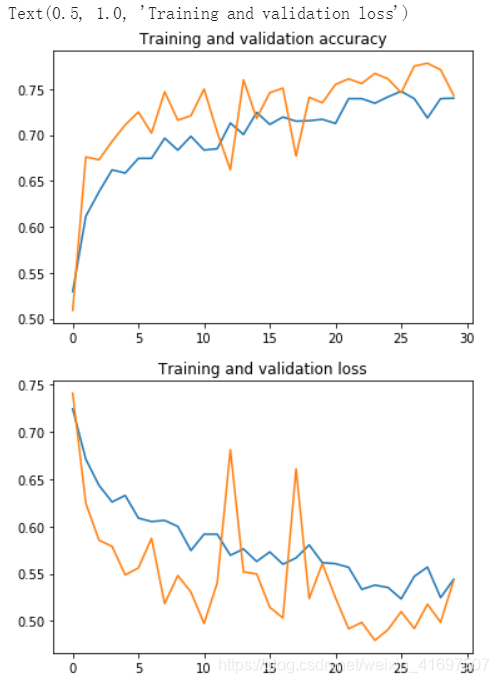猫与狗图像分类
练习2:减少过度拟合
预计完成时间:30分钟
在这个笔记本中,我们将基于我们在练习1中创建的模型来对猫与狗进行分类,并通过采用一些策略来减少过度拟合来提高准确性:数据增加和退出。
我们将遵循以下步骤:
1.通过对训练图像进行随机变换来探索数据增强的工作原理。
2.将数据扩充添加到我们的数据预处理中。
3.将退出添加到预定。
4.重新训练模型并评估损失和准确性。
让我们开始吧!
探索数据扩充
让我们熟悉数据增强的概念,这是对抗计算机视觉模型过度拟合的重要方法。
为了充分利用我们的一些训练样例,我们将通过一系列随机变换“增强”它们,这样在训练时,我们的模型将永远不会看到完全相同的两次图片。这有助于防止过度拟合,并有助于模型更好地概括。
这可以通过配置要对我们的`ImageDataGenerator实例读取的图像执行的多个随机转换来完成。让我们开始一个例子:
from tensorflow.keras.preprocessing.image import ImageDataGenerator
datagen = ImageDataGenerator(
rotation_range=40,
width_shift_range=0.2,
height_shift_range=0.2,
shear_range=0.2,
zoom_range=0.2,
horizontal_flip=True,
fill_mode='nearest')
这些只是一些可用的选项(更多信息,请参阅[Keras文档](https://keras.io/preprocessing/image/)。让我们快速浏览一下我们刚写的内容:
rotation_range是一个度数(0-180)的值,一个随机旋转图片的范围。width_shift和height_shift是范围(作为总宽度或高度的一部分),在其中垂直或水平地随机翻译图片。shear_range用于随机应用剪切变换。zoom_range用于随机缩放图片内部。horizontal_flip用于水平随机翻转一半图像。当没有水平不对称假设(例如真实世界的图片)时,这是相关的。fill_mode是用于填充新创建的像素的策略,可以在旋转或宽度/高度偏移后出现。
我们来看看我们的增强图像。首先让我们设置我们的示例文件,如练习1中所示。
注意:本练习中使用的2,000张图片摘自Kaggle提供的[“Dogs vs. Cats”数据集](https://www.kaggle.com/c/dogs-vs-cats/data) ,其中包含25,000张图片。在这里,我们使用完整数据集的子集来减少用于教育目的的培训时间。
!wget --no-check-certificate \
https://storage.googleapis.com/mledu-datasets/cats_and_dogs_filtered.zip -O \
/tmp/cats_and_dogs_filtered.zip
import os
import zipfile
local_zip = '/tmp/cats_and_dogs_filtered.zip'
zip_ref = zipfile.ZipFile(local_zip, 'r')
zip_ref.extractall('/tmp')
zip_ref.close()
base_dir = '/tmp/cats_and_dogs_filtered'
train_dir = os.path.join(base_dir, 'train')
validation_dir = os.path.join(base_dir, 'validation')
# Directory with our training cat pictures
train_cats_dir = os.path.join(train_dir, 'cats')
# Directory with our training dog pictures
train_dogs_dir = os.path.join(train_dir, 'dogs')
# Directory with our validation cat pictures
validation_cats_dir = os.path.join(validation_dir, 'cats')
# Directory with our validation dog pictures
validation_dogs_dir = os.path.join(validation_dir, 'dogs')
train_cat_fnames = os.listdir(train_cats_dir)
train_dog_fnames = os.listdir(train_dogs_dir)
接下来,让我们将datagen转换应用于训练集中的猫图像,以生成五个随机变体。 重新运行细胞几次以查看新批次的随机变体。
%matplotlib inline
import matplotlib.pyplot as plt
import matplotlib.image as mpimg
from tensorflow.keras.preprocessing.image import array_to_img, img_to_array, load_img
img_path = os.path.join(train_cats_dir, train_cat_fnames[2])
img = load_img(img_path, target_size=(150, 150)) # this is a PIL image
x = img_to_array(img) # Numpy array with shape (150, 150, 3)
x = x.reshape((1,) + x.shape) # Numpy array with shape (1, 150, 150, 3)
# The .flow() command below generates batches of randomly transformed images
# It will loop indefinitely, so we need to `break` the loop at some point!
i = 0
for batch in datagen.flow(x, batch_size=1):
plt.figure(i)
imgplot = plt.imshow(array_to_img(batch[0]))
i += 1
if i % 5 == 0:
break
将数据扩充添加到预处理步骤
现在让我们将[Exploring Data Augmentation](#scrollTo = E3sSwzshfSpE)的数据增强转换添加到我们的数据预处理配置中:
# Adding rescale, rotation_range, width_shift_range, height_shift_range,
# shear_range, zoom_range, and horizontal flip to our ImageDataGenerator
train_datagen = ImageDataGenerator(
rescale=1./255,
rotation_range=40,
width_shift_range=0.2,
height_shift_range=0.2,
shear_range=0.2,
zoom_range=0.2,
horizontal_flip=True,)
# Note that the validation data should not be augmented!
test_datagen = ImageDataGenerator(rescale=1./255)
# Flow training images in batches of 32 using train_datagen generator
train_generator = train_datagen.flow_from_directory(
train_dir, # This is the source directory for training images
target_size=(150, 150), # All images will be resized to 150x150
batch_size=20,
# Since we use binary_crossentropy loss, we need binary labels
class_mode='binary')
# Flow validation images in batches of 32 using test_datagen generator
validation_generator = test_datagen.flow_from_directory(
validation_dir,
target_size=(150, 150),
batch_size=20,
class_mode='binary')
如果我们使用此数据增强配置训练新网络,我们的网络将永远不会看到相同的输入两次。 然而,它看到的输入仍然是非常相互关联的,所以这可能不足以完全摆脱过度拟合。
添加Dropout
另一种对抗过度拟合的流行策略是使用Dropout。
提示:要了解有关辍学的更多信息,请参阅[机器中的[培训神经网络](https://developers.google.com/machine-learning/crash-course/training-neural-networks/video-lecture) 学习速成课程](https://developers.google.com/machine-learning/crash-course/)。[链接文字](HTTPS://)
让我们从练习1重新配置我们的convnet架构,在最终分类层之前添加一些丢失:
from tensorflow.keras import layers
from tensorflow.keras import Model
from tensorflow.keras.optimizers import RMSprop
# Our input feature map is 150x150x3: 150x150 for the image pixels, and 3 for
# the three color channels: R, G, and B
img_input = layers.Input(shape=(150, 150, 3))
# First convolution extracts 16 filters that are 3x3
# Convolution is followed by max-pooling layer with a 2x2 window
x = layers.Conv2D(16, 3, activation='relu')(img_input)
x = layers.MaxPooling2D(2)(x)
# Second convolution extracts 32 filters that are 3x3
# Convolution is followed by max-pooling layer with a 2x2 window
x = layers.Conv2D(32, 3, activation='relu')(x)
x = layers.MaxPooling2D(2)(x)
# Third convolution extracts 64 filters that are 3x3
# Convolution is followed by max-pooling layer with a 2x2 window
x = layers.Convolution2D(64, 3, activation='relu')(x)
x = layers.MaxPooling2D(2)(x)
# Flatten feature map to a 1-dim tensor
x = layers.Flatten()(x)
# Create a fully connected layer with ReLU activation and 512 hidden units
x = layers.Dense(512, activation='relu')(x)
# Add a dropout rate of 0.5
x = layers.Dropout(0.5)(x)
# Create output layer with a single node and sigmoid activation
output = layers.Dense(1, activation='sigmoid')(x)
# Configure and compile the model
model = Model(img_input, output)
model.compile(loss='binary_crossentropy',
optimizer=RMSprop(lr=0.001),
metrics=['acc'])
重新训练模型
随着数据增加和退出,让我们重新培训我们的convnet模型。 这一次,让我们训练所有2000个可用图像,包括30个时期,并对所有1,000个测试图像进行验证。 (这可能需要几分钟才能运行。)看看你是否可以自己编写代码:
# WRITE CODE TO TRAIN THE MODEL ON ALL 2000 IMAGES FOR 30 EPOCHS, AND VALIDATE
# ON ALL 1,000 TEST IMAGES
解决方案
单击下面的解决方案。
history = model.fit_generator(
train_generator,
steps_per_epoch=100,
epochs=30,
validation_data=validation_generator,
validation_steps=50,
verbose=2)
请注意,在数据增加到位的情况下,每次新的训练时期运行时,2,000个训练图像都会随机变换,这意味着模型在训练期间将永远不会看到相同的图像两次。
评估结果
让我们用数据增加和退出来评估模型训练的结果:
# Retrieve a list of accuracy results on training and test data
# sets for each training epoch
acc = history.history['acc']
val_acc = history.history['val_acc']
# Retrieve a list of list results on training and test data
# sets for each training epoch
loss = history.history['loss']
val_loss = history.history['val_loss']
# Get number of epochs
epochs = range(len(acc))
# Plot training and validation accuracy per epoch
plt.plot(epochs, acc)
plt.plot(epochs, val_acc)
plt.title('Training and validation accuracy')
plt.figure()
# Plot training and validation loss per epoch
plt.plot(epochs, loss)
plt.plot(epochs, val_loss)
plt.title('Training and validation loss')
好多了! 我们不再过度拟合,我们已经获得了大约3个验证准确率百分点(参见顶部图表中的绿线)。 事实上,根据我们的培训资料,我们可以保持我们的模型超过30多个时代,我们可能达到~80%!
清理
在运行下一个练习之前,运行以下单元格以终止内核并释放内存资源:
import os, signal
os.kill(os.getpid(), signal.SIGKILL)





